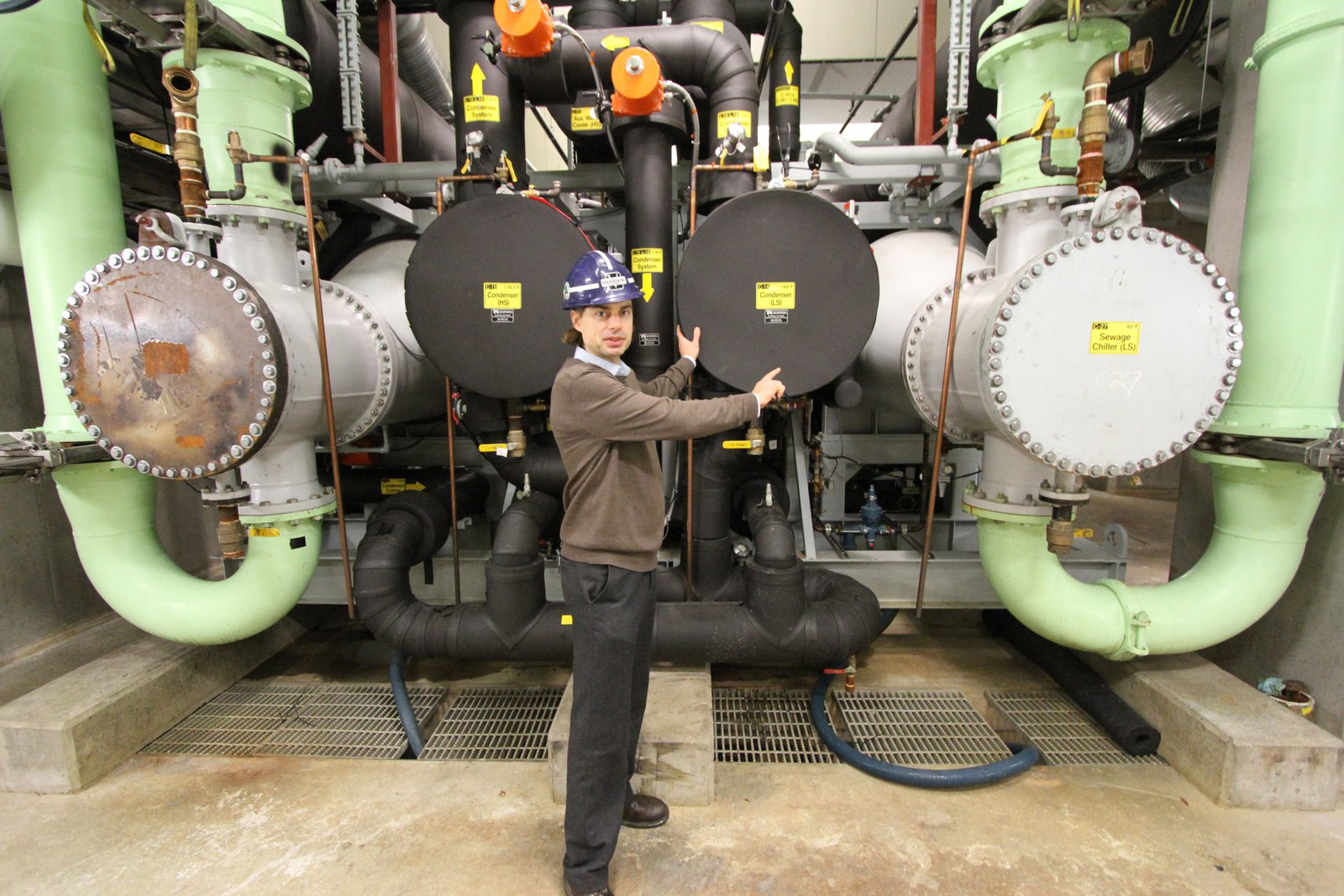By David Dodge and Duncan Kinney
Like the Teenage Mutant Ninja Turtles we head into the sewers, pizza in hand, to explore a scheme to bathe the city of Vancouver (or at least one neighborhood) in near-boiling hot water.
No it’s not another evil scheme hatched by the Shredder, it’s a district-heating scheme that mines heat from sewage and saves tonnes of greenhouse gas emissions.
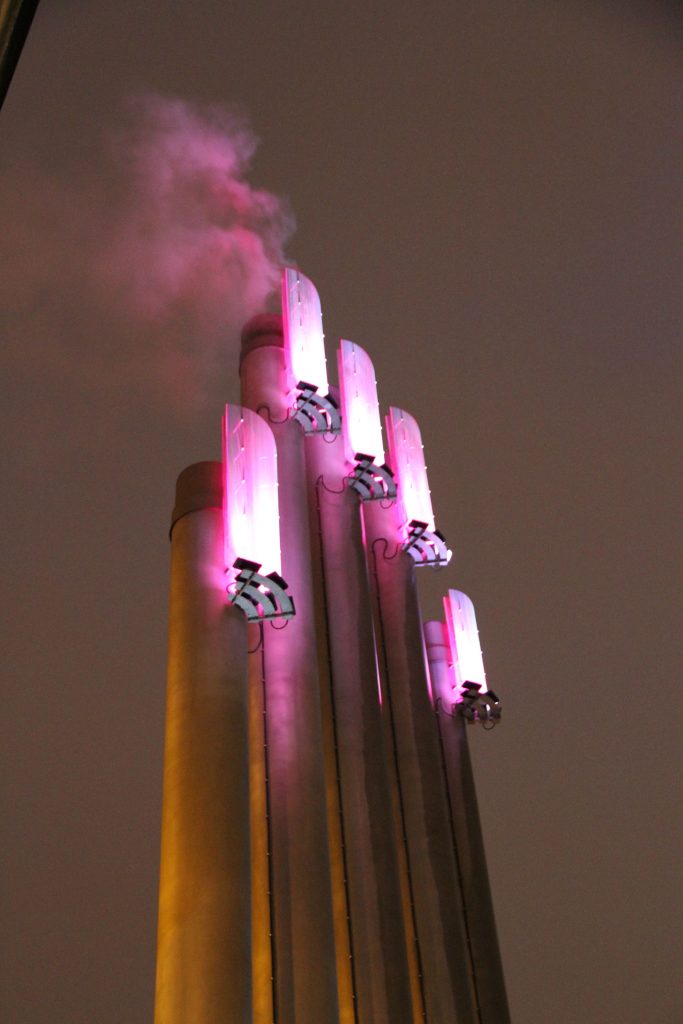
The lit up smokestacks outside of the False Creek Energy Centre.
When you hear energy efficiency nerds talk about waste heat they’re typically talking about the leftover, excess heat from industrial uses. Today we’re literally talking about waste heat – it turns out you can heat 250,000 square metres (with many more to come) with the water that ends up in the sewer.
The False Creek Energy Centre is tucked under the Cambie Bridge in downtown Vancouver with a five-fingered smokestack lit by purple lights marking its position. Its cutesy exterior belies a serious district-heating machine. It goes deep underground and it feels a bit like an ultra-modern cave troll lair from the future. The deeper you go the louder it gets and it would have been foreboding if I didn’t have the helpful Chris Baber giving the tour.
He’s the neighborhood utility manager for the False Creek Energy Centre and is in charge of the day-to-day operations of this sewage heat recovery operation. And for someone who has to deal with sewage all day he’s a pretty cheerful guy.
“Smells like money,” he says standing on a walkway overlooking the wet wells, as tens of thousands of litres of sewage streams underneath our feet. Ok the gunky sewage is pretty stinky, but it wasn’t as bad as I imagined.
The good old fashioned heat pump
It might sound fancy but the technology in play here is already in every home – the heat pump. Just like the geoexchange systems from our geothermal episode, heat pumps are a very common piece of equipment. Every fridge has a heat pump that strips heat from the air making your fridge nice and cool for your veggies and cold cuts.
However, it’s pretty clear that this isn’t a regular heat pump. It’s an imposing piece of machinery the size and shape of a semi-trailer truck.
This sewage heat recovery system is the first in North America, with the other systems in Oslo, Norway and Tokyo, Japan.
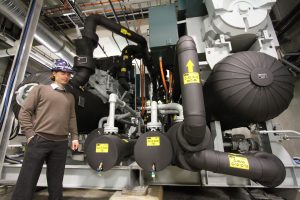
Chris Baber shows the heat pumps that provide 3.2 MW of heat for hot water and heating from sewage at the False Creek Energy Centre.
The process has a couple of steps. First the sewage is run through a filter to get any nasties out, then it’s pumped through the heat exchange system where the large, custom designed heat pump strips the heat out. That heat is then upgraded and transferred to pipes which carry the hot water into the homes and buildings of the nearby customers.
Roughly 70 per cent of the total heating energy comes from the 3.2 megawatt sewage heat recovery system with the rest coming from a large set of natural gas boilers. The natural gas boilers are there for backup when the system needs maintenance and for the chilliest days of the year when there is a big demand for heat.
District heating schemes make a lot of sense in dense urban environments. A furnace in everyone’s basement can’t compete with the efficiency and economies of scale you get from a large heating plant.
“It’s basically a shared infrastructure platform that has the economies of scale and adaptability to plug in a variety of renewable low-carbon energy sources that otherwise wouldn’t be feasible on an individual building,” says Baber.
While this district heating scheme runs on waste sewage heat and natural gas they can run on any number of technologies.
Perhaps not surprisingly, Iceland has the largest penetration of district heating systems anywhere in the world with 95 per cent market penetration, mostly from geothermal. Denmark comes in second with roughly 60 per cent of the population getting their heat from district heating schemes mostly from biomass.
Carbon savings
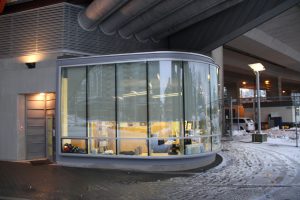
The False Creek Energy Centre.
But the real reason the City of Vancouver installed this system was for the greenhouse gas savings. Vancouver has ambitious goals about all buildings built after 2020 to be carbon neutral and with 55 per cent of all of the energy use in Vancouver happening via buildings it’s going to take some work.
The False Creek Energy Centre reduces greenhouse gas emissions by around 70 per cent according to Baber (74 per cent in the first four months of 2012 according to this city report). Vancouver is able to get these carbon savings while using a large electric heat pump because of the low carbon hydroelectric plants that powers the province.
While this idea might not work in every province, it is certainly working in Vancouver and it even works as a selling feature.
“Many of our customers really appreciate the fact that by virtue of living in this area and connecting to a system they have a significantly smaller greenhouse gas footprint than a resident in a comparable neighborhood with comparable lifestyle,” says Baber.
The price
Now it’s not all sunshine and lollipops. The cost to heat any building that’s connected to natural gas infrastructure has dropped to historic lows. The shale gas boom in North America means natural gas is uber-cheap right now and even with the low-cost B.C. hydro grid this sewage waste heat system has about a 10 per cent premium attached to it.
However, the advantage of this system is price stability. While natural gas is cheap right now neither you, nor I, nor the pointy heads sitting in front of four computer screens can predict the price of natural gas in the future.
“Natural gas prices fluctuate considerably and it’s fairly difficult for someone who uses a lot of natural gas to really predict how much he’ll be spending on it from year to year,” says Baber.
“The people that are connected to this system should benefit because we get most of our heating from sewage and because that sewage is basically free. We don’t have the same exposure to variations in gas prices that other heat users might have. So, over the long term we expect customers to have very stable and predictable rates.”
Plans to expand
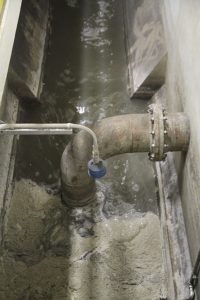
The wet wells of the False Creek Energy Centre. That’s raw sewage
There are big plans for the False Creek Energy Centre. The plan is to go from heating 250,000 square metres to 650,000 square metres as more nearby buildings get connected.
The city is planning to develop the False Creek Flats area on the other side of False Creek as well.
“So over time we can add new pipe, connect new buildings and when the amount of energy demand exceeds with this this system can produce, we just build another energy center in another location,” says Baber.
“It’s fairly modular, it’s very expandable and it’s very adaptable to different energy sources. It’s really all about adaptability, future-proofing and enabling the recovery of waste heat that otherwise there’d be no economical technical way of recovering.”
We don’t often think about the energy we flush down the toilet or that goes down the drain, but luckily we’ve got people working on projects like the False Creek Energy Centre that can see the value in the stuff we throw away.
~30~
